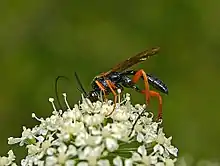Pimpla rufipes
Pimpla rufipes, the black slip wasp, is a species of wasp belonging to the family Ichneumonidae.[1][2]
| Pimpla rufipes | |
|---|---|
 | |
| Male Pimpla cf. rufipes | |
| Scientific classification | |
| Kingdom: | |
| Phylum: | |
| Class: | |
| Order: | |
| Family: | |
| Subfamily: | |
| Genus: | |
| Species: | P. rufipes |
| Binomial name | |
| Pimpla rufipes (Miller, 1759) | |
| Synonyms | |
| |
Distribution and habitat
This species can be found in most of Europe, in North Africa and from Iran, Russia, India, China up to Korea and Japan (Afghanistan, Albania, Algeria, Armenia,Australia, Austria, Azerbaijan, Azores, Belarus, Belgium, Bulgaria, China, Croatia, Cyprus, Czech Republic, Slovakia, Denmark, Egypt, Estonia, Finland, France, Georgia, Germany, Greece, Greenland, Hungary, Iceland, India, Iran, Ireland, Italy, Japan, Kazakhstan, Korea, Kyrgyzstan, Latvia, Libya, Lithuania, Macedonia, Madeira Islands, Malta, Moldova, Mongolia, Morocco, Netherlands, Norway, Poland, Romania, Russia, Serbia & Montenegro, Slovakia, Spain, Sri Lanka, Sweden, Switzerland, Tajikistan, Tunisia, Turkey, Turkmenistan, Ukraine, United Kingdom, Uzbekistan, former Yugoslavia).[3][4] These wasps mainly inhabit hedgerows and vegetated areas.[5]
Description
Pimpla rufipes can reach a length of about 15 millimetres (0.59 in).[5] These wasps are generally sturdy black with bright orange legs. The hind legs are larger than the other pairs. The ovipositor is straight, quite short and thick. The first tergite is box like with the spiracle anterior to the middle.[5][6]
Biology
The main hosts of this parasitic wasp are the large white butterfly (Pieris brassicae) and the gypsy moth (Lymantria dispar).[7] The fertilized females of these wasps lay an egg in the pupae of those lepidopterans. The hatched larvae feed on the pupae. Adults usually feed on flowers. They overwinter.[5][8]
References
| Wikispecies has information related to Pimpla rufipes. |
| Wikimedia Commons has media related to Pimpla rufipes. |
- Brulle, M.A. (1846) Tome Quatrieme. Des Hymenopteres. Les Ichneumonides., In: Lepeletier de Saint-Fargeau A. "Histoire Naturelles des Insectes." Paris. pp. 56-521
- Hymenoptera Online
- Fauna Europaea
- Yu, Dicky Sick Ki. "Pimpla rufipes (Miller 1759)". Home of Ichneumonoidea. Taxapad. Archived from the original on March 24, 2016.
- Nature Spot
- Nicola Prehn & Chris Raper Beginner's guide to identifying British ichneumonids
- BioLib
- "Insectoid". Archived from the original on 2016-12-27. Retrieved 2017-12-21.